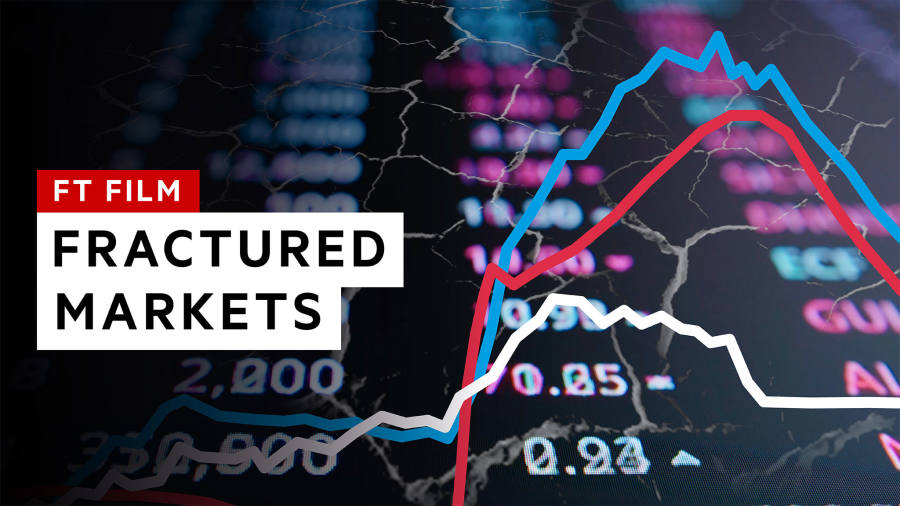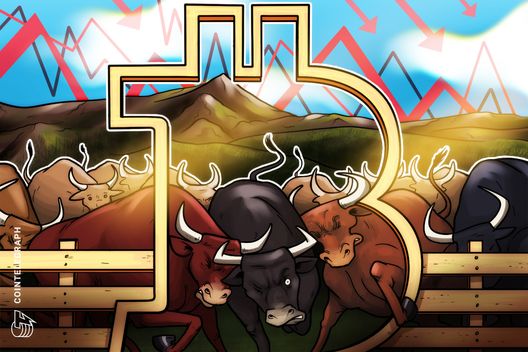Fractured markets: the big threats to the financial system
21 min read
You can enable subtitles (captions) in the video player
[MUSIC PLAYING]
TOMMY STUBBINGTON: This is a story of a world that became addicted to low interest rates.
HARRIET AGNEW: It’s a tale of what can happen when the era of cheap money comes to an end.
KATIE MARTIN: Investors have just been spoiled for like two decades by super low interest rates, and it’s over. The game is up. Inflation is here for the first time in most investors’ living memories. And this changes everything.
JIM LEAVISS: 30 years of falling bond yields perhaps coming to an end. Suddenly we’re at an inflexion point. We’re seeing some cracks in the financial system.
TOMMY STUBBINGTON: What a decade of easy monetary policy did was encourage people to take greater risks.
DAVID OLDER: When you see rates rise as quickly as they have, often there are things that break.
COLBY SMITH: At no time have we seen such a complicated constellation of risks.
KATIE MARTIN: It’s only when the tide goes out that you see who’s been swimming naked.
TOMMY STUBBINGTON: So let’s rewind to 2008. You have this huge global financial crisis.
JIM LEAVISS: And that was due to leverage, too much borrowing, particularly in the US mortgage market.
DAVID OLDER: The result of that was the need for incredible liquidity injections into the financial system.
COLBY SMITH: In the immediate aftermath of the global financial crisis, central banks really had to sit on their hands. Economies globally were so lacklustre, and the recovery was so slow. And central banks weren’t grappling with high inflation. They were grappling with what to do with incredibly low inflation.
TOMMY STUBBINGTON: And central banks around the world respond to the recession that follows by slashing interest rates, by buying up vast quantities of government debt under their quantitative easing programmes.
JIM LEAVISS: This was a new thing, really. We saw central banks buying back huge amounts of government bond markets. Trillions and trillions of dollars’ worth of government IOUs ended up being owned by central banks instead of by traditional investors.
DAVID OLDER: And that did set forth a paradigm, if you will, of inexpensive money and a feeling that there was a Fed put below the markets. The Federal Reserve and central banks globally were able to achieve this because there was no inflation.
TOMMY STUBBINGTON: Financial markets in particular get conditioned to this world where every time something goes wrong, a central bank comes riding to the rescue.
JIM LEAVISS: Ever since that point, we’ve had loose monetary policy with interest rates heading all the way down to zero. If you went back to a couple of years ago, most of the government bond markets of the world had negative yielding government bonds, which is just extraordinary.
MEGAN GREENE: Now that existed up until the pandemic hit. And then you had central banks and governments step in pretty aggressively to support the economy while we put the economy into a deep freeze.
JIM LEAVISS: The global financial crisis followed by a eurozone crisis followed by COVID– three big things coming in rapid succession. In a way, we’ve almost forgotten what normal looks like.
KATIE MARTIN: There is everything that leads up to COVID and the invasion of Ukraine, and there is everything after.
TOMMY STUBBINGTON: What’s changed? In one word, inflation.
DAVID OLDER: There was a belief that inflation was transitory, that this was caused by supply chain issues during COVID, by a tight labour market because of COVID, and that would recede, and you’d see inflation coming down. The realisation by central banks that this was not the case, that inflation was stickier earlier this year, led to this very steep rise in interest rates.
COLBY SMITH: The Federal Reserve officially changed its monetary policy framework to tolerate higher periods of inflation. What the Fed did not envision– that this framework would become operational just as inflation was starting to become a much more persistent issue.
JIM LEAVISS: Post COVID, everybody wanted to get out there again and start flying, start eating out in restaurants at the same time that we had people who had left the labour force and a lot of supply bottlenecks, the perfect breeding ground for some inflation, sustained by the war in Ukraine. So suddenly you had energy prices going through the roof.
[EXPLOSION]
KATIE MARTIN: The world has changed. The world is different. Inflation is here for the first time in most investors’ living memories.
TOMMY STUBBINGTON: We’ve ended up in a world where inflation’s at 10%. Now what we have is central banks around the world scrambling to stop inflation running away.
MEGAN GREENE: In every major economy, except for in China and in Japan, we have central banks that are aggressively tightening rates and also withdrawing liquidity from the markets. The Fed is shrinking its balance sheet. The Bank of England has started quantitative tightening. The ECB is starting to talk about quantitative tightening.
COLBY SMITH: Financial markets definitely got used to this notion that interest rates would be low for quite a long time. People really did not grapple with the fact that interest rates were going to have to be significantly higher. What we hear from officials is that it’s not going back to the way it was any time soon.
DAVID OLDER: You have inflation for the first time in 40 years limiting their ability to use monetary policy and inject liquidity in the same way. So as a result, we’re seeing a drainage of liquidity globally, higher rates, and a new paradigm.
TOMMY STUBBINGTON: You can no longer buy up government debt every time there’s a wobble in the markets because you need to concentrate on your main mission, which is fighting inflation.
MEGAN GREENE: There’s so much uncertainty that investors are pulling their money out of the markets into cash as well. So that’s further withdrawing liquidity.
KATIE MARTIN: The first really big rake that has been stepped on here is in the UK pension sector.
KWASI KWARTENG: The Bank of England are taking further steps to control inflation, acting–
TOMMY STUBBINGTON: Let’s rewind to September the 23rd. We have the gilt market, which is expecting this new government to come out with a package of energy subsidies. What they didn’t expect is that the government would pile a load of unfunded tax cuts on top of this, borrowing even more money than the market realised. It was going to be the supply of gilts, the supply of new debt that the UK government has to raise has suddenly gone up.
KATIE MARTIN: The UK government bond market, generally on the boring side– it’s a rinky-dink little market compared to the US Treasuries market. It got fried.
HARRIET AGNEW: The market freaked out because essentially the government was saying, we need to borrow much more money at a time where it’s going to get even more expensive to borrow money. This drove a sharp sell-off in the UK government bond market. The speed and scale of the move in the gilts market was unprecedented, and this is what caused a shock.
TOMMY STUBBINGTON: The supply of something goes up. Investors respond by selling it. You see UK borrowing costs leap higher on the day of the budget.
JIM LEAVISS: That it was going to result in the biggest amount of gilt issuance that we’ve ever seen. The more bonds that are issued, the more that the market has to buy, the lower price the government will have to sell those at.
TOMMY STUBBINGTON: Pound crashes to its all-time low against the dollar. Usually higher interest rates would be good for your currency. But we have this sense that the international investment community has lost confidence in UK economic policymaking.
MEGAN GREENE: And that caused a whole bunch of forced selling in the LDI market.
TOMMY STUBBINGTON: Liability-driven investing or LDI has been at the centre of this. This is a strategy used by certain pension schemes to protect them against big swings in interest rates. The reason that they need to do that is because moves in long-term interest rates mean that their liabilities, the money that they have to pay out to pensioners for decades in the future, swings up and down wildly.
Now one way that they can protect themselves against that is by owning lots of gilts– gilts, long-term government bonds, that will also see wild swings in their prices as long-term interest rates move. That works if you are able to fill your pension portfolio with 100% gilts. In practise, it doesn’t work that way. There are shortfalls in the funding of these schemes, so they need to buy riskier assets as well.
KATIE MARTIN: The returns that you can get out of bonds have been falling for years. So they think, well, we need to enhance returns. They need to hedge themselves against the risk that bond yields could fall further.
JIM LEAVISS: And that’s where derivatives come in that effectively synthetically create the same effect of holding long-term gilts, but using leverage, using borrowed money.
KATIE MARTIN: The problem is that if bond yields rise, pension funds have to pay out that money. That can mean that they have to sell assets really quickly.
JIM LEAVISS: As gilt yields climbed rapidly in the wake of the budget, that meant that those swapped positions, moved against the pension funds. The type of moves that are supposed to be only seen once in a generation in the gilt market– we had that happening three days in a row.
HARRIET AGNEW: So when the gilt price fell, the yields rose. And this meant that pension funds faced collateral calls.
TOMMY STUBBINGTON: They had to raise new cash, and they had to raise it fast.
KATIE MARTIN: Selling of UK government bonds meant more selling of government bonds. And it spiralled incredibly quickly. And it very quickly became a threat to financial stability in the UK.
TOMMY STUBBINGTON: This is a slow-moving industry. These guys are not used to responding to market conditions on a day-by-day basis. LDI was a strategy that was sold to companies as something that you can lock away in the drawer and not think about. It wasn’t supposed to be something where pensions trustees and where companies had to think fast about which assets they can liquidate in order to meet margin calls on their collateral positions.
HARRIET AGNEW: If the Bank of England hadn’t stepped in, there would have been this doom loop of asset sales, where it becomes a sort of self-fulfilling prophecy. And you sell prices into a falling market, and prices keep on falling. And then you risk contagion across other parts of the market.
JIM LEAVISS: The Bank of England announces that it’s prepared to buy up to 65 billion pounds’ worth of gilts, of long-term gilts, over the next 13 days, which effectively looks like a return to the days of quantitative easing precisely at the time when they’re trying to back away from policies like that.
KATIE MARTIN: The Bank of England had to step in. Something had to give. Ordinary people who pay mortgages could see that the rates on those mortgages were shooting through the roof. Mortgage lenders were pulling out of the market.
TOMMY STUBBINGTON: It could have developed into a financial crisis.
DAVID OLDER: The LDI dynamic exposed the stresses that can happen in the system when you have a very sharp rise in interest rates. Loose fiscal policy combined with an inflationary backdrop– very dangerous. And I think the financial markets really forced a coherence in fiscal policy. The Bank of England’s response to that was a tactical response– inject liquidity for a moment in time to reverse the quantitative tightening policy they had.
MEGAN GREENE: If the Bank of England hadn’t stepped in as the market-maker of last resort, I think we would have had a Lehman-type event where you had a bunch of UK pensions go bust. Pension funds knew that the Bank of England wasn’t going to let them go bankrupt. There was some reticence to unwind their positions, which is why the governor, Andrew Bailey, created this deadline and really stuck to it so that pension funds would have to unwind it rather than just handing it over to the Bank of England and allowing the Bank of England to take the losses.
KATIE MARTIN: It was very, very tightly targeted. It wasn’t a monetary policy move. They were at pains to point out that this isn’t more easing. This is just us making sure that the system can hold.
TOMMY STUBBINGTON: Central banks like the Bank of England wear two different hats. One of them is to set monetary policy and control inflation, and the other one is to protect financial stability. Now for most of the last decade, those two things have worked pretty well hand in hand. When you had no inflation and low interest rates, it was easy to ride to the rescue on financial stability grounds without compromising your monetary policy. With high inflation, you can’t do that anymore. Your financial stability function no longer pushes in the same direction as monetary policy.
KATIE MARTIN: The question is very much whether this is a very British problem or whether the UK is a taste of things to come.
HARRIET AGNEW: The crisis that we’ve seen in the UK pension fund market could be a harbinger of what’s to come elsewhere.
DAVID OLDER: When you see rates rise as quickly as they have, often there are things that break.
MEGAN GREENE: There are going to be a bunch of market dislocations, and it’s going to be central banks that are going to have to step in to paper them over, even as they’re trying really hard to fight inflation.
KATIE MARTIN: One of the most famous and oft-repeated phrases that you ever hear of financial markets is the famous quote from Warren Buffett. “It’s only when the tide goes out that you see who’s been swimming naked.”
MEGAN GREENE: It’s a great metaphor for where we are now, because as the liquidity is withdrawn, we can see where all the vulnerabilities are because they’re going to blow up.
TOMMY STUBBINGTON: Which investment strategies, which business models no longer work in a world of rising interest rates?
KATIE MARTIN: Once all of that lovely liquidity is gone, then you find out what’s really at risk.
HARRIET AGNEW: In a bull market, almost everything goes up, and you can’t see the problems in the portfolio. It’s only when the tide goes out and the markets turn that you see where the issues are or who’s got their trunks down.
KATIE MARTIN: If you’re looking for who’s been swimming naked, there’s a lot of skinny-dippers out there.
TOMMY STUBBINGTON: The places to look are wherever there’s leverage in the system, wherever there’s borrowed money. When markets move a long way quickly, people lose money on their leveraged positions. And they’re forced to sell assets in a disorderly way, which exacerbates the moves and creates even wider problems.
HARRIET AGNEW: After the financial crisis, global regulators did a lot of work to make the banks safer, as a lot of the risk got pushed away from the banking sector into what we call the shadow banking sector– non-bank players such as hedge funds, private equity, pension funds, and asset managers, the unregulated parts of the financial sector. Before the financial crisis, regulators knew that most of the leverage was in the banks. The problem is now, we don’t really know exactly where the leverage is.
KATIE MARTIN: If this can happen to the gilt market, it could happen to the Japanese government bond market. It could happen to the US Treasuries market. We have to be ready for the possibility that bonds just don’t work like they used to anymore.
MEGAN GREENE: The market dislocations and price moves that we see in global markets over the next year will be as swift and severe as what we saw in the UK with the LDI blow-up. Markets broadly globally are very stressed already.
JIM LEAVISS: Partly it’s driven by a disagreement between governments that want to boost the economy and central banks, like the Bank of England, who want to slow the economy. And that story is going to replay in other parts of the world, including probably this winter in Europe.
TOMMY STUBBINGTON: The European Central Bank has to set policy for lots of countries. That means one of the things that they’re really worried about is the gaps opening up in bond markets between what it costs different countries to borrow. And this is particularly for countries with weaker economies like Italy or Greece. So far, they’ve been able to get away with the threat of buying more Italian bonds to stop this happening.
But again, they face a similar dilemma to the Bank of England. How do you convince people that you’re still committed to fighting inflation and at the same time commit to buy billions of euros of assets in order to stop these cracks opening up in the financial system? The Bank of England certainly sets a precedent for the Fed here.
You can imagine a situation where the Fed is forced to intervene to protect market functioning, while at the same time, they’re moving in the opposite direction in order to reach their monetary policy objectives. It’s a very difficult tightrope to walk when your financial stability and your monetary policy functions are pulling in different directions. And one of the big worries in the US is the smooth functioning of the market for US Treasuries, which is the world’s largest bond market. It’s a fundamental part of the world’s financial plumbing.
KATIE MARTIN: Everything depends on the fate of the US Treasuries market, but there are some real cracks there.
TOMMY STUBBINGTON: Lots of participants in that market have been complaining that liquidity is getting worse, that it’s harder to trade bonds without moving the price, that sometimes it’s simply impossible. That’s a worrying sign when you’re talking about a market that’s so fundamental to the global financial system.
JIM LEAVISS: The US bond market is the interest rate that sets the global interest rate. Everything that happens to US Treasuries has implications for equity markets, property markets, your mortgage rate. Everything is based on US Treasury bond markets.
TOMMY STUBBINGTON: As the Federal Reserve moves to tighten monetary policy by raising interest rates and also by winding down its portfolio of Treasuries, people are worried that those problems may get worse and that you may end up in a place where the Treasury market simply isn’t functioning.
COLBY SMITH: The Treasury market is hands down the world’s most important bond market. So dysfunction in that market is just not going to be tolerated from the Federal Reserve. That being said, there have been cracks. In March 2020, and there was this big, broad dash for cash as investors panicked in the face of the pandemic.
KATIE MARTIN: The nightmare scenario honestly, is that we get anything like the sort of volatility that we’ve seen in gilts happen in US Treasuries.
TOMMY STUBBINGTON: Something similar in the Treasury market is probably a disaster for the global economy.
KATIE MARTIN: Bank of America has done a lot of research into these fragilities that it can see occurring in the US Treasuries market. “If the Treasuries market fails to trade for a period of time, various credit channels, including corporate, household, and government borrowing and securities and loans would cease. This could lead to events such as US government debt default”– not good– “inability to convert Treasuries to cash or meet corporate, household, or government obligations globally, the inability to produce benchmarks that form the backbone of the derivatives market, the inability to issue, trade, or hedge debt of corporates, municipalities, insurance companies, banks.” I could go on– potentially one of the biggest risks to financial stability that there has been anywhere since the housing bubble of 2006, 2007.
MEGAN GREENE: We’re facing into a recession across developed markets, a slowdown in China, unbelievable geopolitical risk, a war in Europe. I think the flight to safety might be a trend that we’ll see over the next year. That should support the US Treasury market.
KATIE MARTIN: The logical conclusion is that there’s simply no way that US authorities would stand back and let that happen. But yields can rise because prices are falling in bond markets much more quickly than we have become used to. So if you have modelling for any kind of hedging contract, anything that’s predicated on rates moving slowly, I would suggest you check the fine print on that pretty quickly.
JIM LEAVISS: Coming from a world where central banks were the number-one buyer of government bond issuance to them being the biggest seller of government bonds, for me and other bond investors, we don’t quite know how well the global markets will be able to digest this additional supply at the same time that government borrowing is already quite high.
COLBY SMITH: No Fed official has officially said we need a recession in order to tame inflation, but all signs point to that having to be the case.
JEROME POWELL: The economy and the country have been through a lot over the past 2 and 1/2 years and have proved resilient.
COLBY SMITH: Chair Jay Powell acknowledged the fact that a recession is a real possibility. And he said something that I think really shocked investors. Everyone wants there to be a painless way to bring inflation down, and there just isn’t. And we constantly hear them reference this 1970s period when inflation got out of control because policymakers prematurely eased policy. And that’s just not a mistake that they’re willing to make this time around.
DAVID OLDER: Jerome Powell has been very clear that he’s willing to accept a weaker stock market in pursuit of lower inflation. But if the credit market seized up and ceased to function, I think the Federal Reserve, just like the Bank of England, would be very quick to intervene and manage that issue.
COLBY SMITH: Big concern is how severe of a crisis we could have going forward. And we often find out when it’s too late.
KATIE MARTIN: The Japanese government bond market is an outlier. Inflation is incredibly low in Japan. Interest rates are held at more or less zero, and bond yields are held incredibly low. The Bank of Japan will probably have to unravel this policy if inflation does start to get sticky.
The big question that investors are asking is, can Japan do this? Can it pull this off without lighting a fuse under the massive Japanese government bond market? Lots of people have spent years looking for some sort of disaster in the Japanese government bond market, and they’ve been disappointed. But what is to say that that market can’t do this? And what is to say what the reaction of Japanese asset managers would be to that? Nobody knows the answer to these questions.
COLBY SMITH: One flash point is what’s going on with emerging and developing economies. These are highly indebted countries intimately affected by rising borrowing costs globally, by a strong dollar. They also do not have the kind of fiscal robustness that would allow them to perhaps weather through various crises. There’s this amazing stat from the IMF. 60% of low income countries are either near or at debt distress already. We could perhaps see a wave of defaults going forward.
DAVID OLDER: Ultra low rates certainly fueled speculative excess. So we saw that in unprofitable growth companies. We saw that in private venture capital-backed companies. We’ve seen it in the crypto world, where there’s a lot of opacity.
HARRIET AGNEW: One area that we might see potential winds next year is the US market for unlisted tech companies. We’ve seen a big sell-off in listed tech companies this year. We’re expecting trouble to fall over into the private markets at some point next year. Companies raise money at sky-high valuations during the good times. And as interest rates rise, they may be forced to do what’s called a down round, which is when they raise money at a big discounted valuation.
MEGAN GREENE: UK specifically I think the mortgage market is a bit of a risk as well, just because the Bank of England will have to hike rates aggressively. And most mortgages are pretty short-term in the UK relative to the US. You could end up having these fixed-term mortgages turn variable with much higher rates. That could blow back on the banks.
JIM LEAVISS: Your mortgage rates are set related to the gilt market yields. So we saw UK mortgage rates start to hit 6, 6 and 1/2. I even saw 7% mortgage rates.
HARRIET AGNEW: When central banks are pouring money into the financial markets, and they’re rising, it’s an incredibly easy environment in which to invest. A rising tide carries all boats.
COLBY SMITH: Low interest rates and ultra-accommodative monetary policy has definitely allowed for more risk taking than I think would have been possible.
TOMMY STUBBINGTON: When you can’t earn a decent yield, a decent interest rate, from buying the safest assets, it pushes you into more dangerous areas, encourages you to take on leverage. You use borrowed money to juice up your returns.
DAVID OLDER: You’ve had a generation of investors, more than a decade, that have gotten used to these tailwinds from low rates, low interest rates, and the ability to fuel the speculative excess.
COLBY SMITH: Investors should absolutely be braced for more surprises. There are pockets of hidden leverage in this economy and financial system that policymakers have not yet identified. The big concern is how quickly those get exposed.
KATIE MARTIN: Nobody thought that inflation could jump to 10%. What if we’ve got double-digit inflation in major economies, and actually we’re going to 15%?
COLBY SMITH: The situation is going to get much dicier. We heard this from the IMF. The worst is yet to come for the global economy and the global financial system. That’s pretty strong language.
INTERVIEWER: Are there any reasons to be cheerful?
[UNCOMFORTABLE GIGGLE]
TOMMY STUBBINGTON: We saw with the UK pensions crisis that the central banks still are able to step in and stop the worst problems without compromising their commitment to fighting inflation.
KWASI KWARTENG: The Bank of England are taking further steps–
KATIE MARTIN: Maybe the mess that happened in the UK around the time of the mini budget is enough of a wake-up call to the rest of the system. If it’s not, then we’re going to get accidents like this happening over and over again for the next few years.
JIM LEAVISS: For inflation rates to stay this high, you’re going to need the oil price to keep going up and up and up. If we ended up with some sort of peace in Ukraine and stability, then we forget about all the extra billions and trillions that governments and consumers are going to have to be spending on energy bills.
KATIE MARTIN: There has been a bit of a pullback in US inflation in the data for October. And the Fed is indicating that maybe it won’t have to raise interest rates quite as quickly as it had previously told the market it would. So that takes the pressure off a bit, but it’s still well above target. And the pressure is still very much on.
JIM LEAVISS: China has been in a zero COVID policy for a very long time. If China opens up in 2023, then that could produce a significant boost to economic activity around the world.
DAVID OLDER: A lot of the pain has been felt in 2022. We’ve seen rates rise very sharply. We’ve seen valuations contract very sharply. Markets are all down. And there’s been a process of understanding that we’re in a different type of paradigm– higher rates, higher inflation for longer.
MEGAN GREENE: It’s hard to imagine that we can tighten monetary policy so aggressively, have a downturn in the economy, and not see a bunch of defaults.
TOMMY STUBBINGTON: This crisis has perhaps less potential to spiral through the financial system.
MEGAN GREENE: We’ve got the plumbing set up much better than we did in 2008 for central banks to go ahead and step in.
TOMMY STUBBINGTON: But at the same time, until inflation can be brought back down and until central banks are in a position where they can reassure the markets rather than scaring them, this is going to continue.
KATIE MARTIN: This is the point where policymakers, regulators, central banks, governments, even, start to think, OK, we have to take this seriously. We cannot take the risk that people’s savings are at risk unduly, that people’s pensions are at risk, that house prices could come under pressure, or, more importantly, that people’s mortgage rates could absolutely shoot through the roof.
JIM LEAVISS: We could see trade unions on the rise again, having been extinct effectively since the 1980s and 1970s. And we could see wages start to increase.
KATIE MARTIN: The system was absolutely addicted to cheap money. One investor was putting it to me the other day. It’s absolutely naive to think that we can get out of this low interest rate environment without some sort of blow-up.
[MUSIC PLAYING]







